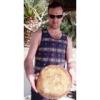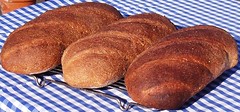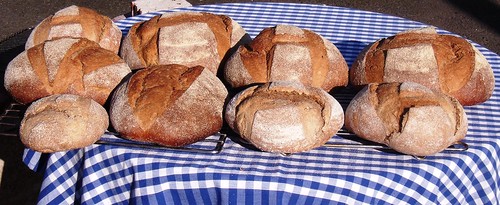
1st March 2012 Premature Springtime Baking
1st March 2012 Premature Springtime Baking
Today I made some breads to begin re-stocking the freezer for the next market. It has been a beautiful day; a real pleasure to get out onto the patio and work on the oven.
The 3 wholemeal bloomers are yeasted, made with an overnight sponge. The Gilchesters’ loaves are the same as the last few batches; a mixer and oven full! The Pumpernickel is an authentic one. Thank you to Mini for clarifying this; these loaves contain only RYE. There is “altus” from Borodinsky bread, then there is Whole Rye berries, Cracked Rye grain and Dark and Light Rye Flours. Add a little Blackstrap Molasses and Salt to complete the formula. Apologies, but I don't have photos as this bread isstill in the oven just now.
1. Wholemeal Bloomers
Material/Stage | Formula [% of flour] | Recipe [grams] |
1. Overnight Sponge |
|
|
Marriage’s Organic Strong White Flour | 25 | 500 |
Water | 15 | 300 |
Fresh Yeast | 0.2 | 4 |
TOTAL | 40.2 | 804 |
|
|
|
2. Final Dough |
|
|
Overnight Sponge [from 1] | 40.2 | 804 |
Marriage’s Organic Strong Wholemeal | 75 | 1500 |
Fresh Yeast | 1.8 | 36 |
Salt | 1.5 | 30 |
Water | 56 | 1120 |
TOTAL | 174.5 | 3490 |
|
|
|
% pre-fermented flour | 25 | - |
% overall hydration | 71 | - |
% wholegrain flour | 75 | - |
FACTOR | 20 | - |
Method:
- Make the sponge the night before and leave covered to ferment.
- Calculate water temperature needed for DDT of 28°C. Combine Water and Wholemeal in the mixer, then autolyse for one hour.
- Add the Salt, Fresh Yeast and Sponge and mix with the hook attachment for 2 minutes on first speed and 4 minutes on second speed. Scrape down, rest for 10 minutes, then mix a further 1 minute on first speed and 2 minutes on second speed.
- Bulk proof, maintaining the dough temperature @ 25°C for 2 hours with S&F after 1 hour.
- Scale and divide: 3 bloomers @ 1160g
- Final proof @ 18°C for 2 hours
- Bake in the wood-fired oven for 45 minutes.
- Cool on wires.
2. Gilchesters’ Miche/Boules
Makes 9 loaves: 2 @ 1350g; 3 @ 950g; 3 @ 650g and 1 @ 350g
Levain build:
Day | Time | Stock Levain | Strong White Flour | Water | TOTAL |
| ||
Wednesday | 09:00 | 40 | 200 | 120 | 360 |
| ||
Wednesday | 17:30 | 360 | 500 | 300 | 1160 |
| ||
Wednesday | 21:30 | 1160 | 450 | 270 | 1880 |
| ||
Material/Stage | Formula [% of flour] | Recipe [grams] | ||||||
1. Wheat Levain |
|
| ||||||
Marriage’s Organic Strong White Flour | 25 | 1125 | ||||||
Water | 15 | 675 | ||||||
TOTAL | 40 | 1800 | ||||||
|
|
| ||||||
2. Final Dough |
|
| ||||||
Wheat Levain [from above] | 40 | 1800 | ||||||
Gilchesters’ Organic Farmhouse Flour | 75 | 3375 | ||||||
Salt | 1.8 | 81 | ||||||
Water | 58 | 2610 | ||||||
TOTAL | 174.8 | 7866 | ||||||
|
|
| ||||||
% pre-fermented flour | 25 | - | ||||||
% overall hydration | 73 | - | ||||||
% wholegrain flour [approx 85% extraction] | 75 | - | ||||||
FACTOR | 45 | - | ||||||
Method:
- Build the levain, see description above.
- For mixing, first of all mix the Gilchesters flour with the water, on first speed for 3 minutes with a hook attachment, then autolyse for 1 hour.
- Add the levain and the salt. Mix on first speed only for 10 - 15 minutes. Dough Temperature Calculation worked out as follows: WT = 3[DDT – FRH] – Leaven Temp – Flour Temp. 3[28 – 1] – 18 – 20 = 43. Water temperature required at 43°C. The gentle nature of the mixing action is evident here with just 1°C rise in temperature due to friction!
- Bulk prove the dough maintaining DDT of 26°C for 2 hours, one S&F after one hour.
- Scale and divide as above. Mould round and rest for 15 minutes. Prepare bannetons, re-mould dough pieces and set to final proof.
- Final proof DDT maintained at 26°C, for 3 hours.
- Bake in the wood-fired oven.
- Cool on wires.
3. Black Pumpernickel Bread
Day | Time | Stock Sour | Dark Rye | Water | TOTAL |
Wednesday | 07:30 | 40 | 90 | 150 | 280 |
Wednesday | 14:00 | 280 | 510 | 850 | 1640 |
Material | Formula [% of flour(?)] | Recipe [grams] |
1a. Rye Sour Dough |
|
|
Bacheldre Organic Dark Rye Flour | 30 | 600 |
Water | 50 | 1000 |
TOTAL | 80 | 1600 |
1b. “Altus” |
|
|
Old Bread [Borodinsky] | 11 | 220 |
Molasses | 4 | 80 |
Water | 18 | 360 |
TOTAL | 33 | 660 |
1c. Soaked Rye Berries |
|
|
Organic Whole Rye Berries | 20 | 400 |
Water | 23 | 460 |
TOTAL | 43 | 860 |
2. Final Dough |
|
|
Rye Sour Dough | 80 | 1600 |
Soaked Bread | 33 | 660 |
Soaked Rye Berries | 43 | 860 |
Salt | 1.5 | 30 |
Organic Cracked Rye Grain | 25 | 500 |
Shipton Organic Light Rye 997 | 25 | 500 |
TOTAL | 207.5 | 4150 |
% pre-fermented flour | 30 | - |
% overall hydration | 101 | - |
% wholegrain | 75 [+ 25@997ash] | - |
FACTOR | 20 | - |
Method:
- Build the sour as schedule
- Prepare the “altus” by dissolving the molasses in the water and soaking the bread pieces in the sweet liquor.
- Soak the whole rye grain in cold water for 8 hours; strain off and wash the grain, then cook it for half an hour. Reserve any spare cooking liquid. Cover and cool.
- For the final paste, combine the rye sour, “altus” and cooked rye berries, then add the cracked rye, light rye flour and salt into a mixing bowl. Use the paddle beater and mix to combine on first speed for 2 minutes and second speed for 4 minutes. Scrape down as needed and add the cooking liquor to let the paste down if needed. I added a further 200g at this stage, meaning overall hydration of 101%. I added flour, cracked and wholegrain to come to 100% for the formula but did not include the “altus”. So, there is 2000g rye and 2020g water in the recipe used. DDT is 28°C.
- Bulk proof 1 hour.
- Scale and divide. I used 1 Pullman Pan and 2 other tins with foil lids.
- Final proof 3 hours.
- Bake in the "dead oven", covered, in the wood-fired oven, with steam, for 12 to 16 hours.
- Cool on wires
- Wrap in linen and leave undisturbed ambient for 36 hours before slicing

A very enjoyable day making good bread!
Best wishes
Andy











Comments
Andy, How nice to be able to get out and bake. I know you've posted on the bloomers before but now I'm starting to notice them. I love the way they are scored. Certainly hope to give them a try. I see that your pumpernickel is made with dark rye. I always thought there was a special pumpernickel flour, maybe because King Arthur sells one. You have really perfected the Gilchesters and now are cranking them out in bulk. Very impressive! Best of luck with market day. I'm sure people will make sure to get there early. -Varda
Hi Varda,
In Northumberland we have a choice of 4 organic wholegrain rye flours which are reasonably easy to find, plus the odd "mainstream" rye flour from supermarkets, usually wholegrain, which I have never had to use. Light Rye is harder to find, but there are 2 varieities available, both are Organic. Pumpernickel Flour is not available to my knowledge. But you may have seen a photograph of the Dark Rye which I use? If not, see here:
http://www.thefreshloaf.com/node/23415/baking-allbritish-flour#comment-169076
It's good to read your comment as it is clear you appreciate that I am developing specific breads to form part of the Bread and roses brand. It is encouraging that you also appreciate their honest qualities as well.
Very best wishes
Andy
to open a subsidiary in italy? I may hang my pullman pans to the nails and buy some real bread :-) Those soaked rye grains in the crumb must be so delicious!
I really wish I could find some decent strong wholemeal flour to try those lovelly miches. With wholemeal wheat flour I collected only an impressive record of disasters.
Hello Nico,
I somehow hoped you would catch up with the image of the Pumpernickel crumb; and I am happy at reading your kind words, of course.
Apart from a few devotees such as yourself, are there many people interested in this type of bread?
Bread culture in Italy must be very diverse as the climate varies so much from the Alps in the far north to the searing heat in the far south. Learning about the Tumminia wherat from you made our trip to Sicily so much more rewarding. But I'm lefty wondering what the rye heritage really is?
Onto wholemeal. It is an unpredictable flour at the best of times. I'm away on business as I write this reply; in Scotland doing consultancy work. I made some wholemeal bread today using Pate Fermentee to make panned breads. Very poor they were too. Flour is good, dough too. Final result really not good! And yet these Gilchesters loaves are made with high extraction, not wholemeal; flour is grown in Northern UK, so really not strong! The wholemeal bloomers here are a real winner, however. A joy to make and bake in my brick oven
Wonderful to hear from you
Best wishes
Andy
none! Even in the few places on the Alps where rye bread is traditionally prepared there are very few people that appreciate a 100% rye bread like yours and mine. I guess that the fellowship in all italy can be counted on the fingers of a hand, sadly! People here want bread made mostly of thick and crackly crust; even a soft crumb is seen more as a necessary evil than the "real thing" a bread is all about.
Your bloomers have me craving some rare roast beef topped on a nice big buttered slice. Your formula's/recipes are always so nicely written up. All the loaves browned up so very, very nicely...I hope to see a picture posted of the pumpernickel March 2nd :)
Sylvia
Hi Sylvia,
I have now posted a photo of the crumb of the pumpernickel, and hope you approve.
I really appreciate your positive comments about these breads, of course; thank you very much.
Neither Alison nor I have eaten meat in over 27 years, so rare beef wouldn't be my choice to accompany the bloomer, but there are lots of good things to go with this bread, as it is really an everyday sort of loaf...and it's got plenty of bran, vitamin and mineral bonuses too, of course!
Lovely to hear from you, as ever
Best wishes
Andy
looks gorgeous. Thank you for the photo. If I could bake pumpernickel like that, I would hand slices of it out like gold nuggets, it looks that delicious and nutritious! I think I do recall now one of my senior lost moments, reading in an older post, you and yours do not eat meat. I must have grossed you out with the sandwich :/
Sylvia
Hello Andy,
Don't the crusts of those bloomers and boules look wonderful, in your springtime sunshine?
So glad you had a warm and sunny day to bake these.
It is so good to see the crumb of the Black Pumpernickel - how did it taste?! (must have been amazing)
:^) breadsong
We've had some lovely weather over the last week Breadsong!
Today was horrible, and I'm not sure how tomorrow will be, but I have got a lot of baking lined up!
I'm not very good with a camera, but being able to take shots of bread outside in the sunshine makes so much difference.
I cannot stop munching on the Pumpernickel; love it!
Very good to hear from you
All good wishes
Andy
for your recipies and methods. Your breads are just picture perfect and surly very tasty indeed. You bake so many great rye breads, what do you think makes this one a pumpernickel as opposed to another rye variety? I can't figure out what makes a pumpernickel a pumpernickel and am interested in your thoughts on this.
Hello dabrownman,
Thank you for your kind words.
I always believed a Pumpernickel to be a combination of different grinds of grain...wholegrain, chopped or cracked grain, wholegrain flour and white flour, plus judicious use of "altus". It was Mini Oven who passed on the additional requirement that this grain is "all rye". That suits me perfectly, as I have a lot of customers who cannot eat wheat. I am busy working away to produce a range of good rye breads which are all "wheat-free"! Still this needs some tweaking in the baking stage, but the formula is bang-on!
Best wishes
Andy